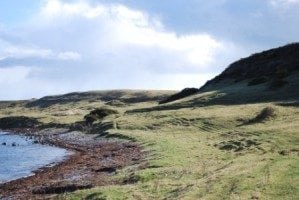- Created: August 28, 2012 10:32 am
- Updated: December 12, 2017 11:02 am
Categories:
Location: Down
- Distance Instructions
Label
- Distance 0 m
- Time 0 s
- Speed 0.0 km/h
- Min altitude 0 m
- Peak 0 m
- Climb 0 m
- Descent 0 m
Killard Point, situated to the south of Strangford Lough, is surrounded by fine views of the Mourne Mountains, the Lecale landscape and the Isle of Man. Saint Patrick is said to have preached to the fishes here in 432 AD. Recorded history dates from 1403 and over the years it has been managed as a rabbit warren, for common grazing and a hurling pitch existed until 1932.
From 1952 to 1978, the flat top served as an RAF radar station, now included in the reserve. The last ice-age created interesting geological features, including cliffs formed from a mixture of debris deposited as the ice melted. Exposed bedrock on Benderg beach has been worn smooth by the movement of ice sheets. The banks in July and August are alive with butterflies, common blues, meadow browns and in some years painted ladies abound. Look out for the bizarre six-spot Burnet, a day-flying moth and listen for grasshoppers on sunny days.
The abundant grassland flowers colour the landscape through the seasons. In early May, the blues of spring squill and bluebells appear. Through June, yellow flowers of bulbous buttercup, kidney vetch and wild pansies predominate. In July, restharrow, centaury and pyramidal orchids change the scene to pink while in August the rich purples of knapweed, thyme and field scabious complete the picture. Many of the plants found are uncommon or rare in Ulster. Thousands of orchids flowering in late June produce a display unequalled in the province. Notable birds include fulmars and sand martins on the cliffs and stonechats amongst the scrub.
(from DOE)
Gallery
Killard Point, situated to the south of Strangford Lough, is surrounded by fine views of the Mourne Mountains, the Lecale landscape and the Isle of Man. Saint Patrick is said to have preached to the fishes here in 432 AD. Recorded history dates from 1403 and over the years it has been managed as a rabbit warren, for common grazing and a hurling pitch existed until 1932.
From 1952 to 1978, the flat top served as an RAF radar station, now included in the reserve. The last ice-age created interesting geological features, including cliffs formed from a mixture of debris deposited as the ice melted. Exposed bedrock on Benderg beach has been worn smooth by the movement of ice sheets. The banks in July and August are alive with butterflies, common blues, meadow browns and in some years painted ladies abound. Look out for the bizarre six-spot Burnet, a day-flying moth and listen for grasshoppers on sunny days.
The abundant grassland flowers colour the landscape through the seasons. In early May, the blues of spring squill and bluebells appear. Through June, yellow flowers of bulbous buttercup, kidney vetch and wild pansies predominate. In July, restharrow, centaury and pyramidal orchids change the scene to pink while in August the rich purples of knapweed, thyme and field scabious complete the picture. Many of the plants found are uncommon or rare in Ulster. Thousands of orchids flowering in late June produce a display unequalled in the province. Notable birds include fulmars and sand martins on the cliffs and stonechats amongst the scrub.
(from DOE)


